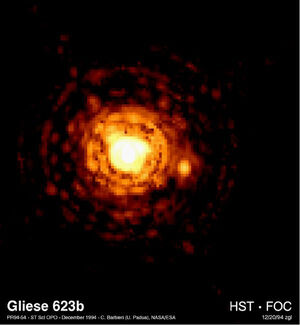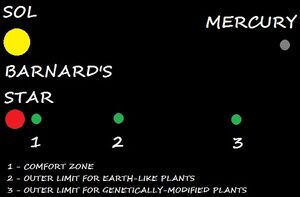For a classification of stars see The H-R Diagram. Additional information can be found on Main Sequence Stars and Main Sequence M Type Objects - Habitable Simulation.
M-type stars are the most common stars in the universe, known as red dwarfs. Their mass is below 40% of the mass of our sun, Sol. Their luminosity is very dim and red in color. These stars have very long lifetime because they burn their hydrogen slowly. An Earth-like planet would be in a torch orbit. A Habitable Zone exists around the vast majority of red dwarfs. Good examples are Barnard's Star, Lalande 21185, Wolf 359 and Luyten 726-8 system hosting UV Ceti.
Most M - type stars have extensive flares and are known as Flare Stars.
The star[]
Red dwarfs can be divided into two main groups: flare stars and more stabile, "friendly" stars. One good example of a flare star is UV Ceti, while one more friendly star is Barnard's Star. Around a flare star like UV Ceti (see image to right), flares can reach huge dimensions, increasing stellar energy output by many times in only a few seconds. Solar spots can form anytime and decrease luminosity by a few times. This will be a nightmare for settlers trying to make a new Earth here. On the other hand, Barnard's Star is far more friendly, but not safe. It still blows flares, terrorizing its planets, but such events are far more rare.
The light of a red dwarf is different from the light generated by Sol. Ultraviolet light is almost absent, so an ozone layer might not be needed. X-rays are generated mainly within flares. Majority of light comes into infrared. Visible light is more into the red spectra. Visible light might be up to 1 000 000 times less powerful then the Sol. For Barnard's Star, it is 0.000441 [1], however infrared light is about 10 times more intense.
Solar winds are very small, except for the flare periods.
Due to low mass, very few red dwarf stars become red giants as the minimum mass required to become one is a third of Sol's mass.
Hosted planet[]
Planets around red dwarfs are not easy to terraform. One of the main reason is light. For example, Barnard's Star has a dim red light. At the distance of only 0.021 AU, this tiny star shines in visible light like the Sun seen from Earth. However, since most of the light is in infrared, the same temperatures will be expected to be found around 0.047 AU (giving an orbital period of only 7 days). A similar situation can be found for other red dwarfs [2].
A Habitable Zone is expected to be found at an orbit 10 times closer than Mercury! But what would that mean? When settlers try to farm, the stars light will not provide all the wavelengths that Earth-like plants will need. Red light is around 10% of Sol's light at Earth's orbit, while blue light is only at 1%. By using greenhouse gasses, settlers will be able to terraform even more distant planets, but there is a limit. If light (red or blue) is below 0.1% of the equivalent light on Earth, plants will die. This means that without an additional source of light, plants will only survive with 10% of the light in the classic habitable zone. Genetically modified plants might use only red light, but still when that light is too dim (0.2% of Earth equivalent light, assuming that half will be used like blue light), they will die too. Based on these, we can conclude that the outer limit for terraforming a planet around Barnard's Star is:
- Roughly 0.06 AU/30 light seconds without greenhouse gasses (10% red light, 1% blue light, related to Earth)
- 0.15 AU/75 light seconds with greenhouse gasses, for Earth-like plants (1% red light, 0.1% blue light)
- 0.33 AU/3 light minutes with greenhouse gasses, for genetically modified plants (0.2% red light).
Tidal forces are very strong at such proximity to the host star. A planet on an elliptical orbit will experience strong forces, similar to the moon Io from Jupiter. However, from Saturn's moons, Enceladus is geologically active, while the closer Mimas is not. So, there might be planets with more or less volcanic activity. It is almost certain the planet will be tidally locked, showing the same face to the star. At higher distances (over 0.2 AU) it is possible that planets will not be tidally locked. Those planets would rotate slowly, like Venus or Mercury.
Environmental features are dependent on planetary details. One TV model proposes a planet with the dark side covered by eternal glaciers, a gigantic endless hurricane in the center of the daylight side and a large temperate ring surrounding it separating the day and night sides. Another model proposes a dark side covered with water and a day side with life. The eyeball planet theory might work very well here.
One different scenario is that the planet will have basically all types of climate found on Earth, but without seasons. It will have in the center an equatorial forest, it will have deserts and savannas (without a wet and dry season, only with different amounts of rain). Temperate forests might look like an eternal spring, where flowers blush from time to time and you can see both flowers and fruits on the same plant. Closer to the twilight zone, you might find Siberian woods and artic tundra, but all of them looking the same. No winter, no summer. Also, because plants follow light, you might see trees growing tilted, trying to 'reach' the fixed sun, just like plants in a room are twisted towards the window.
One thing is for sure. A tidally locked planet will have a very predictable climate, without seasons or days. Winds will follow constant paths along a continuous global circuit connecting both sides. Strong and constant winds will provide settlers with enough energy for all their needs.
Closer distance to the star is the point where a planet can no longer resist the powerful gravity forces and breaks apart. However, that distance is not so far. In Solar System, Mercury can be terraformed. Around a red dwarf, a Mercury type of planet would fit very close to the smallest safe distance. So, any planet found on a close orbit around a red dwarf can theoretically be terraformed.
Another problem is that since a terrestrial planet must be so close, it will not have safe orbits for moons.
Since planets will be tidally locked, their dynamo will work slow. This is not a problem, since red dwarfs have less powerful solar winds (except for the flares, which are very powerful at this torch distance).
The biggest challenge for settlers will more than likely be the powerful flares (see Flare Stars). Depending on the amount of flares, some red dwarfs (like UV Ceti) are unlikely to host habitable planets. Planets closely orbiting flare stars would almost certainly have no atmosphere as powerful flares would blown such away a long time ago. Even a strong magnetic field is not enough to stop these bursts. Their power is similar to solar flares, but because planets with liquid water are so close (20 times closer then the Earth), the effect is huge. Some stars, have such violent flares that their light can increase 100 times. Others, like Proxima Centauri, generate a flare every two hours. A more massive star will not have so many flares like a smaller star. Stars with spectral type M0, M1, M2 and M3, are much more safe. Stars with spectral types fainter than M4 (M5, M6, M7 and below) will be more unstable. Stars that rotate faster will also have more flares. Since older stars rotate slower, it can be said that older stars are more safe. In fact Barnard's Star is older than our galaxy (and one of the most safe red dwarfs). The Internet Stellar Database lists safe red dwarfs with an additional n letter, while flare stars have an additional e attached to their spectral class.
Nearby red dwarfs - complete list available here
- Proxima Centauri of Alpha Centauri (flare star) - 4.24 LY
- Barnard's Star (safe) - 5.98 LY
- Wolf 359 (flare star) - 7.78 LY
- Lalande 21185 (safe) - 8.29 LY
- UV Ceti & BL Ceti of Luyten 726-8 (flare stars) - 8.73 LY
- Ross 154 (safe) - 9.68 LY
- Ross 248 (flare star) - 10.32 LY
Since red dwarfs are the longest lived among all main sequence stars, they might be the last refuge for civilizations that will exist closer to the end of the universe.

